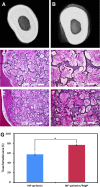Magnesium-containing nanostructured hybrid scaffolds for enhanced dentin regeneration
- PMID: 24593189
- PMCID: PMC4161063
- DOI: 10.1089/ten.TEA.2013.0741
Magnesium-containing nanostructured hybrid scaffolds for enhanced dentin regeneration
Abstract
Dental caries is one of the most prevalent chronic diseases in the United States, affecting 92% of adults aged 20-64 years. Scaffold-based tissue engineering represents a promising strategy to replace damaged dental structures and restore their biological functions. Current single-component scaffolding materials used for dental tissue regeneration, however, cannot provide the proper microenvironment for dental stem/progenitor cell adhesion, proliferation, and differentiation; new biomimetic hybrid scaffolds are needed to promote better dental tissue formation. In this work, we developed a biomimetic approach to prepare three-dimensional (3D) nanofibrous gelatin/magnesium phosphate (NF-gelatin/MgP) hybrid scaffolds. These scaffolds not only mimic the nanostructured architecture and the chemical composition of natural dentin matrices but also constantly present favorable chemical signals (Mg ions) to dental pulp stem cells (DPSCs), thus providing a desirable microenvironment to facilitate DPSC proliferation, differentiation, and biomineralization. Synthesized hybrid NF-gelatin/MgP possesses natural extracellular matrix (ECM)-like architecture, high porosity, high pore interconnectivity, well-defined pore size, and controlled Mg ion release from the scaffold. Adding MgP into NF-gelatin also increased the mechanical strength of the hybrid scaffold. The sustained release of Mg ions from the NF-gelatin/MgP (MgP=10% wt/wt) scaffold significantly enhanced the proliferation, differentiation, and biomineralization of human DPSCs in vitro. The alkaline phosphatase (ALP) activity and the gene expressions for odontogenic differentiation (collagen I [Col I], ALP, osteocalcin [OCN], dentin sialophosphoprotein [DSPP], and dentin matrix protein 1 [DMP1]) were all significantly higher (p<0.05) in the NF-gelatin/MgP group than in the NF-gelatin group. Those results were further confirmed by hematoxylin and eosin (H&E) and von Kossa staining, as shown by greater ECM secretion and mineral deposition in the hybrid scaffold. Consistent with the in vitro study, the DPSCs/NF-gelatin/MgP constructs produced greater ECM deposition, hard tissue formation, and expression of marker proteins (DSPP, DMP1, Col I) for odontogenic differentiation than did the DPSCs/NF-gelatin after 5 weeks of ectopic implantation in rude mice. The controlled release of metallic ions from biomimetic nanostructured hybrid scaffolds, therefore, is a promising approach to enhancing the biological capability of the scaffolds for dental tissue regeneration.
Figures











Similar articles
-
Nano-Structured Gelatin/Bioactive Glass Hybrid Scaffolds for the Enhancement of Odontogenic Differentiation of Human Dental Pulp Stem Cells.J Mater Chem B. 2013 Oct 7;1(37):4764-4772. doi: 10.1039/C3TB21002B. J Mater Chem B. 2013. PMID: 24098854 Free PMC article.
-
Complete pulpodentin complex regeneration by modulating the stiffness of biomimetic matrix.Acta Biomater. 2015 Apr;16:60-70. doi: 10.1016/j.actbio.2015.01.029. Epub 2015 Jan 30. Acta Biomater. 2015. PMID: 25644448
-
Simvastatin and nanofibrous poly(l-lactic acid) scaffolds to promote the odontogenic potential of dental pulp cells in an inflammatory environment.Acta Biomater. 2018 Mar 1;68:190-203. doi: 10.1016/j.actbio.2017.12.037. Epub 2017 Dec 30. Acta Biomater. 2018. PMID: 29294374 Free PMC article.
-
Expression of Odontogenic and Osteogenic Markers in DPSCs and SHED: A Review.Curr Stem Cell Res Ther. 2017;12(1):71-79. doi: 10.2174/1574888x11666160815095733. Curr Stem Cell Res Ther. 2017. PMID: 27527527 Review.
-
Scaffolds for Dentin-Pulp Complex Regeneration.Medicina (Kaunas). 2023 Dec 20;60(1):7. doi: 10.3390/medicina60010007. Medicina (Kaunas). 2023. PMID: 38276040 Free PMC article. Review.
Cited by
-
Synthetic materials in craniofacial regenerative medicine: A comprehensive overview.Front Bioeng Biotechnol. 2022 Nov 9;10:987195. doi: 10.3389/fbioe.2022.987195. eCollection 2022. Front Bioeng Biotechnol. 2022. PMID: 36440445 Free PMC article. Review.
-
Multipotent Differentiation of Human Dental Pulp Stem Cells: a Literature Review.Stem Cell Rev Rep. 2016 Oct;12(5):511-523. doi: 10.1007/s12015-016-9661-9. Stem Cell Rev Rep. 2016. PMID: 27240827 Review.
-
Multifunctional peptide-conjugated nanocarriers for pulp regeneration in a full-length human tooth root.Acta Biomater. 2021 Jun;127:252-265. doi: 10.1016/j.actbio.2021.03.059. Epub 2021 Apr 1. Acta Biomater. 2021. PMID: 33813092 Free PMC article.
-
Odontogenic Differentiation of Human Dental Pulp Stem Cells on Hydrogel Scaffolds Derived from Decellularized Bone Extracellular Matrix and Collagen Type I.PLoS One. 2016 Feb 16;11(2):e0148225. doi: 10.1371/journal.pone.0148225. eCollection 2016. PLoS One. 2016. PMID: 26882351 Free PMC article.
-
Evaluation of dental pulp stem cells behavior after odontogenic differentiation induction by three different bioactive materials on two different scaffolds.BMC Oral Health. 2023 May 1;23(1):252. doi: 10.1186/s12903-023-02975-3. BMC Oral Health. 2023. PMID: 37127635 Free PMC article.
References
-
- Selwitz R.H., Ismail A.I., and Pitts N.B.Dental caries. Lancet 369,51, 2007 - PubMed
-
- Dental Caries (Tooth decay) www.nidcr.nih.gov/DataStatistics/FindDataByTopic/DentalCaries/ (accessed November13, 2013)
-
- Reeh E.S., Messer H.H., and Douglas W.H.Reduction in tooth stiffness as a results of endodontic and restorative procedures. J Endodont 15,512, 1989 - PubMed
Publication types
MeSH terms
Substances
Grants and funding
LinkOut - more resources
Full Text Sources
Other Literature Sources
Research Materials
Miscellaneous

